As Google has evolved from a simple question and answer engine into a service that can utilize machine-learning to provide the best solution for a users’ needs (especially with the introduction of RankBrain), the practice of search engine optimization has to move away from single-keyword applications into focusing on the whole user experience.
In this article, we will identify the essential pieces of information that you will need to display to your potential customers, to show social proof, build customer confidence, and ultimately increase clicks-through-rate to your online storefront. We will focus specifically on implementing structured data snippets to display rich results for users and provide examples of brands that are executing these tactics to perfection.
What Are Rich Results?
Rich results, formerly known as rich snippets or rich cards, are enhanced Google search engine result snippets that offer interactive or additional visuals. Here is an example of a rich result on a SERP:
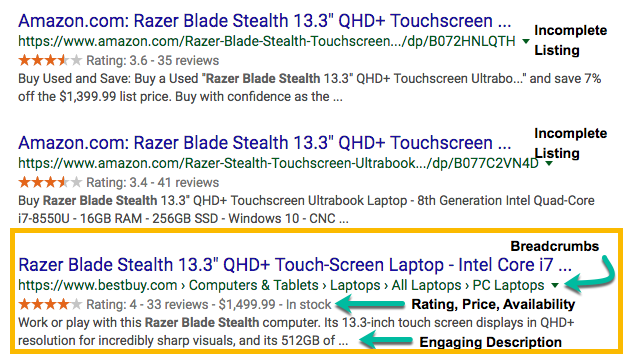
Both users and search engines have gotten smarter, and older SEO tactics will no longer be sufficient for winning over new traffic to your website. Take the example above, for the Razer Blade Stealth laptop. The listing for Best Buy does not even show up until position three, drowned out by two Amazon search listings. However, Best Buy is the only complete rich result in this example, making it look more credible. The extra work this team put in to give users all the information they need to properly tee-up their expectations will go a long way here.
By marking this URL up with several types of structured data from Schema.org, Best Buy has made this listing eligible to display rich results including breadcrumbs, aggregate rating, price, and availability.
As you have been scouring the web for the best Black Friday and Cyber Monday deals for you and your loved ones, you have probably encountered a rich result or two without even realizing it. Previously known as “rich-snippets” these elements of the search experience are generally a result of webmasters marking-up eligible items with structured data to provide more context for search engines like Google and also consequently providing more information for searchers that can make or break the click-thru.
BONUS TIP: Though Google may not always take the meta description field seriously (as noted in a study by Yoast in 2018), this can be incredibly important for illustrating product features and differentiators for users before they click-thru to the website. In the example above, one item that stood out to me was the meta description for Best Buy’s listing that called out “incredibly sharp visuals” and “512GB” hard drive space. In a niche that is hyper-focused on technical specifications, these are details that would win me over as a consumer and are lacking from Amazon’s listings.
When your team is writing meta descriptions for your ecommerce products, focus on “hooking” the user in the first sentence, and delivering a strong call-to-action (CTA) to round out the description.
How Can I Use Rich Results to My Advantage as a Merchant?
If you are familiar with search engine optimization (SEO), you have already heard the age-old pitch, “I’ll get you to rank number one on Google.” What many of us will fail to consider until now, is “now what?”. Just having a number one ranking will not pay the bills. Sure, it will help, but focusing on the click-thru-rate on that search listing now that you are at the top of results is what digital marketing is all about — consistent tweaks and improvement to squeeze out the maximum results for the lowest costs. In fact, in a study conducted by Hubspot in 2018, identified that 61% of marketers say improving SEO and growing their organic presence is their top inbound marketing priority. And there is a good reason for that. When done correctly, SEO can have the potential to generate 20 times the traffic of its paid counterparts, according to Jumpshot and Moz in a 2017 study.
Stand Out from Your Online Competition
Rich results give the average ecommerce store the opportunity to stand out, even when you are not number one in the pack. For example, which product in this listing for the query “blue microphones yeticaster price,” would you select?
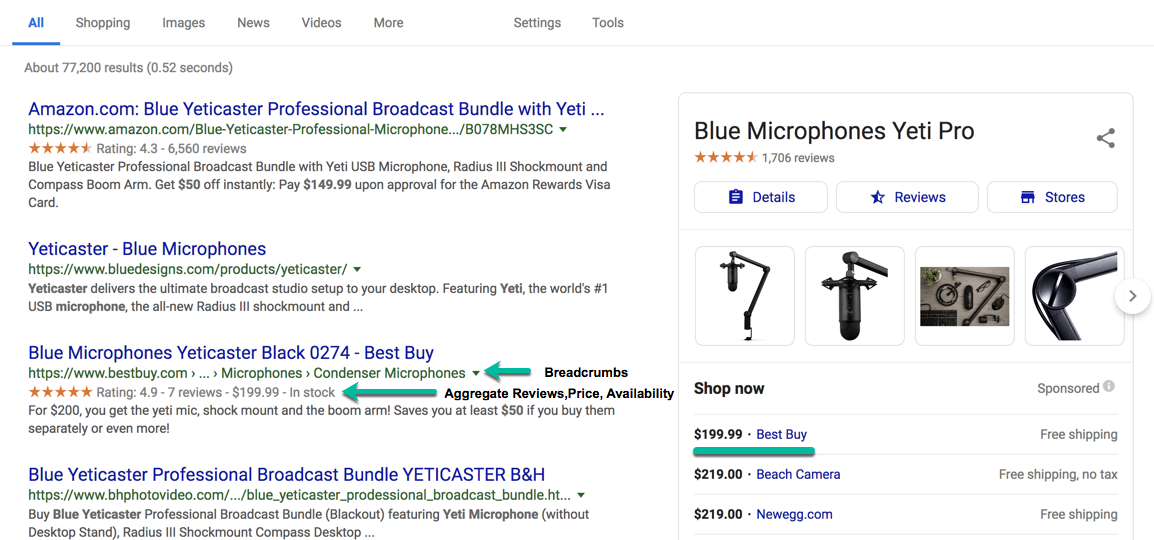
Best Buy has a lot going for them in this specific case. In the Knowledge Panel on the right, they have got the product I am looking for at the lowest price among competitors, along with an aggregate number of 1,706 great reviews. If you scroll down, you will see there is a nice breakdown of these reviews, and Best Buy is the first one that shows up:
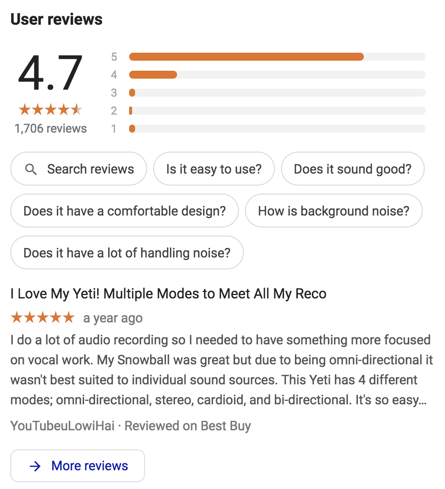
Not to mention that their organic search listing is set-up to meet and exceed my expectations when I click through to the website. I know at an instant that the product is in-stock, has 7 reviews that average 5-stars, and I can expect $199.99 or less for it.
Protect Your Online Reputation
Aside from getting more clicks to your online store, rich results offer a unique opportunity to build and preserve your brand’s reputation. By advertising to searchers that numerous users have reviewed the particular product that is for sale, you send the signal that you are trustworthy; accurately advertising and delivering products to paying customers. I cannot speak for every online consumer, but I personally will not buy a product 9 times out of 10 if it has no reviews associated with it.
What Information Is Important for My Consumers?
1. Product Structured Data
Search engines are very good at reading text on the page and putting together a general idea of what exists for the user, but you as a marketer can help nudge that bot in the right direction. Your first concern as a retailer should be to help Google understand that your page is a product detail page (PDP) (as compared to a blog or resource guide). When the search engine clearly understands the type of page you are presenting it with, it can better position your listing around what the user-intent is; this has become even more important as we have moved away from keywords to full-concepts as RankBrain rolled out.

In the example above from The Home Depot, advertising Christmas trees, you can see that this page is clearly understood to be a product detail page. While we do not see the price and review rich results populating, there are site links that direct users to other product categories on the website that may be relevant to the user’s initial search.

An even better example of a company that carries the same products previously mentioned and does a great job of identifying to Google that the intention of this URL is to sell a product is this listing from Lowes. Note that this search result contains information about the physical dimensions of the product, an aggregate of the customer reviews, and the breadcrumb navigation trail that a user could take to get to it from the homepage.
While it may not directly lead to a higher position in rankings, providing the user with the most information possible before clicking-thru to your website will have a positive impact on your business and likely future-proof as structured data becomes more important in the future.
2. Aggregate Rating Structured Data
Selling a product online without a customer review has become all but impossible, with over 80% of local business consumers saying they trust online reviews as much as a personal recommendation and 69% of online users wanting more reviews from eommerce retailers.
In the case of the same Lowes.com listing we saw above, the company has used the aggregate rating snippet to assert not only that the product they are advertising is good, according to 160 3rd-party reviewers, but also that they are a reputable online business by implementing similar snippets on all of their listings.
As an online consumer like the rest of you, I can admit that I will not buy a product unless the company that is selling it can demonstrate that it is committed to this transparency with its customers.
3. The Price Attribute
One of the first things, aside from social proof (or the aggregate rating), that potential customers will be looking for is the price of the product and how it compares to other sellers.

In the example above, Best Buy does a great job of indicating that the product is in-stock and available now at a price of $1,499.99. Providing searchers with the price, availability, and user rating in one go can have a profound effect on their decision to choose you as they continue their purchase journey.
4. The Availability Attribute
How frustrated were you when the product you had been eyeing for months was out of stock once you got to the store?
Many consumers are shopping online out of convenience and to avoid the frustration explained above. By providing them with availability information in their first impression of your online business (organic search), you are on the right path for building their trust and turning them into long-time customers.

5. Breadcrumb List Structured Data
Just like Hansel and Gretel, your users need to understand where they are landing (their position in your website’s architecture) and how they got there. Additionally, search engines need additional information about how to place your selection of page listings now that they understand the goal of your page is to sell a product.

In the example above, you will see the path the user and/or search engine would take to get to this URL is clearly defined by breadcrumbs noting the path as Home → TV → All Televisions → Full HD & HD TVs.
The bottom line: The better you can define your website’s architecture for users and search engines, the likelier it is you will receive a rankings boost from this breadcrumb information you are providing.
6. Technical Specifications
Would it not be great if you could provide as much information as possible to your potential customers without the use of any code snippets? As of recently, you can! In the example below, you will see an additional element that includes detailed technical specifications for the product listing below the meta description field. This rich element enables customers to get a clear picture of sizing, uses, weight, etc. before even clicking on to the website.

The above example is what I would consider the “perfect listing,” containing all of the rich-elements possible for a product page and giving me as a user all of the tools that I need to make a decision in the least amount of clicks possible. Getting Google to display the technical specifications of your products is as simple as putting this information in a standard HTML table or in some other easily accessible form, no special JSON knowledge required.
How Do I Get Search Engines to Display Rich Results?
Do not worry, in many ecommerce content management systems ( Shopify Plus, Magento, BigCommerce, etc.), you will have the opportunity to implement these items on a global template versus URL by URL.
To start, you will have to inform search engines that your pages contain products, by using the product object as outlined by the authority in structured data, Schema.org. This notation can be used to markup existing on-site text ( Microdata) or live in the background, invisible to the user ( JSON+LD). Once the product object exists, some of our other attributes (price, availability, and aggregate rating) will be nested within it, providing search engines a clear picture of what exists on the page. Breadcrumbs can exist as a separate code snippet.
Microdata
Microdata is a version of structured data that is used to add metadata to content that already exists on the page, visible to users.
Using the example above from AT&T’s listing for the iPad Pro, we can see that their team has implemented properties outlined by the Schema.org website to help search engines better understand this page in the form of microdata snippets.

JSON+LD
JavaScript Object Notation for Linked Data (JSON+LD) is a method of linking data together behind the scenes and is not viewable by your store’s users. Some merchants prefer this to microdata because it is considerably less messy.
Using the example above from Best Buy’s listing for the Razer Blade Stealth 13.3” Laptop, we can see that their team has implemented JSON+LD to inform search engines that a product exists on this page without changing anything on the front-end for the user.
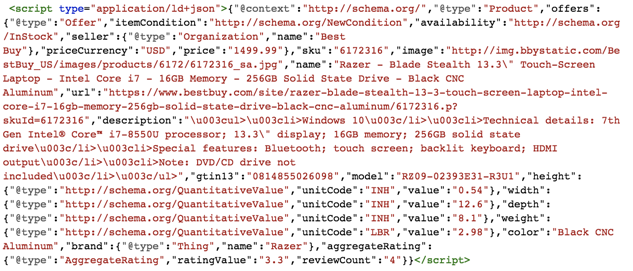
Is It As Easy as Dropping in a Few Lines of Code?
Any SEO veteran will tell you, it depends. Simply injecting some code on to your store’s product pages will provide more context for search engines and enable better comprehension by bits, but it does not guarantee a rich result will show up for each of your search listings. To test the eligibility of individual URLs for rich results, Google has released the Rich Results Test. This tool is currently limited to the following types of structured data, but will be ready to test your products in the near future:
That said, it is still up to the search engine to decide whether or not your page is worthy of these special elements. The best practice is to focus on providing the best quality information to your users, and likely Google’s comprehension of this information will improve with time.
Structured Data Resources
If you felt a little bit lost when we started talking about code snippets, fear not, there is plenty of great tools to help you make sense of it all:
Google’s Structured Data Markup Helper
To get started, all you will need is the URL of the page you are hoping to improve with structured data. Input the URL in the “URL” field and select product under the “Markup Type” section.
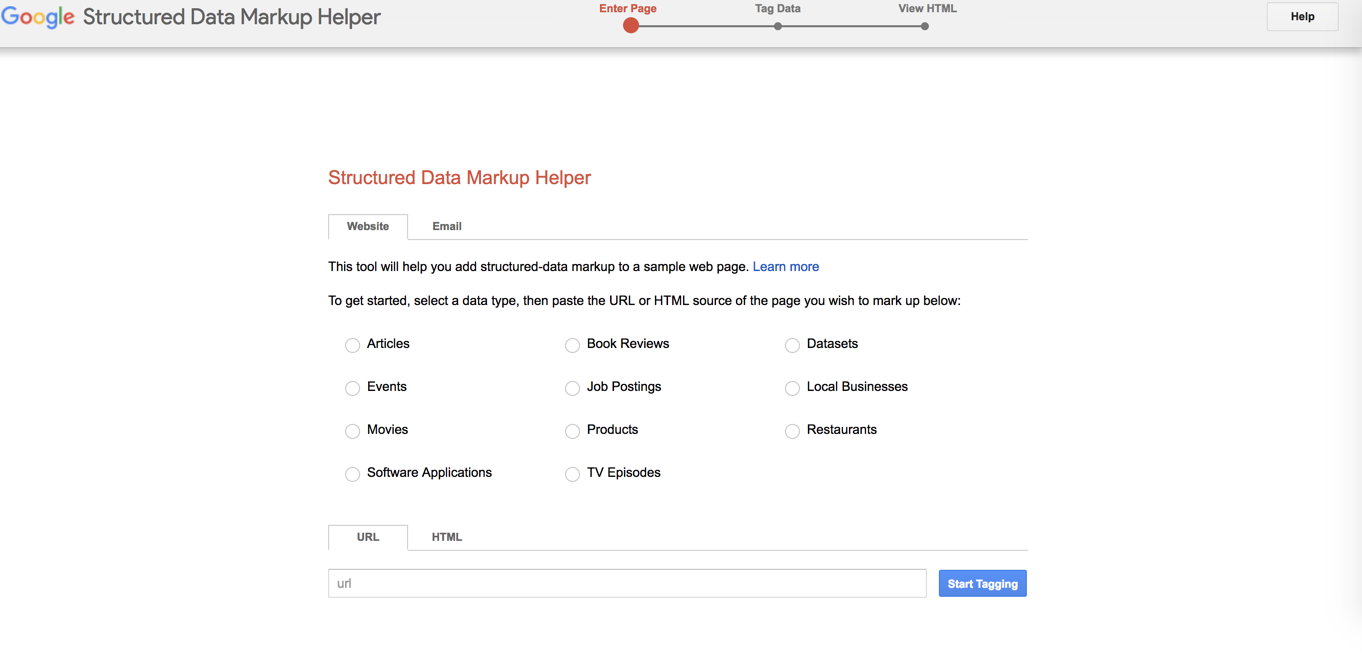
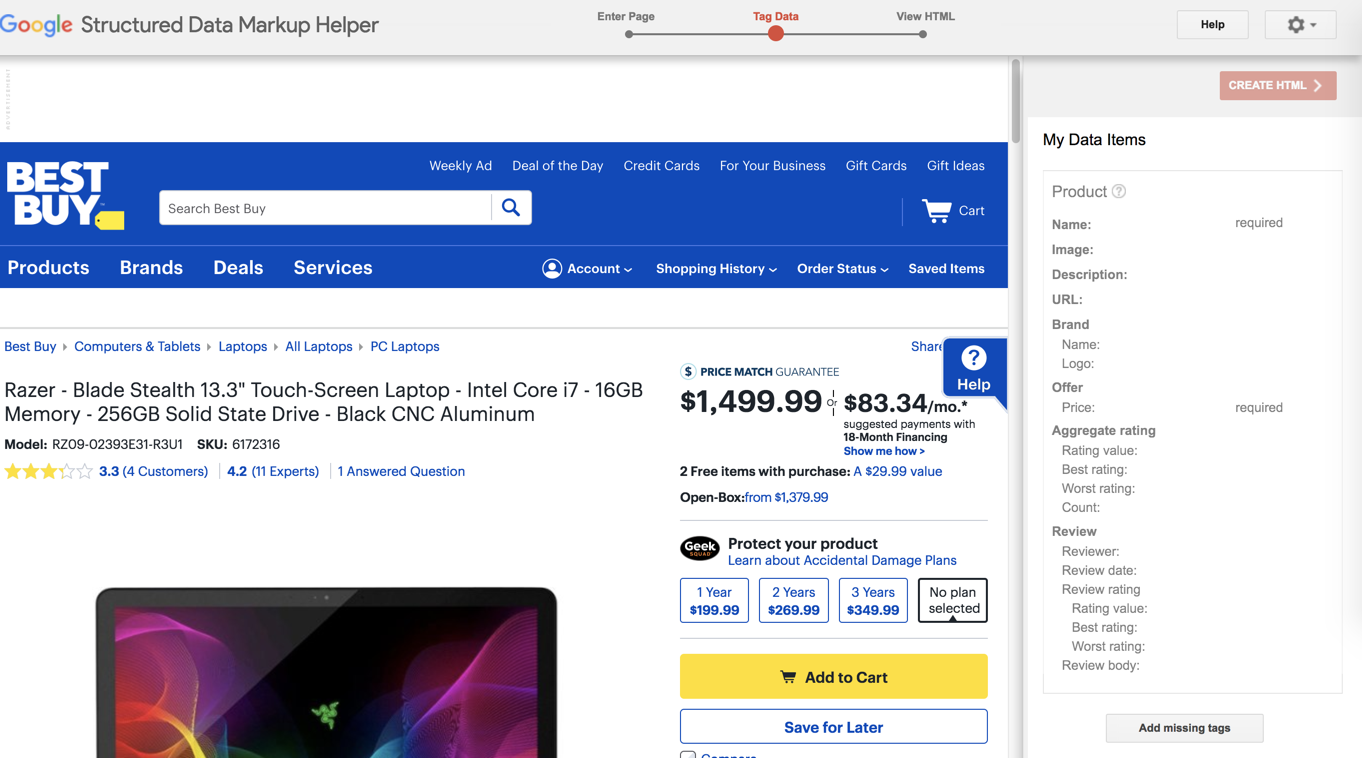
Once you have clicked, “Start Tagging”, you will be met with a page that contains a rendering of your URL and a list of attributes to the right. Select the items on the page you would like to create structured data for, and tag away!
Once you have finished defining attributes, click “Create HTML”, and the tool will provide you with the applicable Microdata or JSON+LD (you can toggle back and forth between the two types).
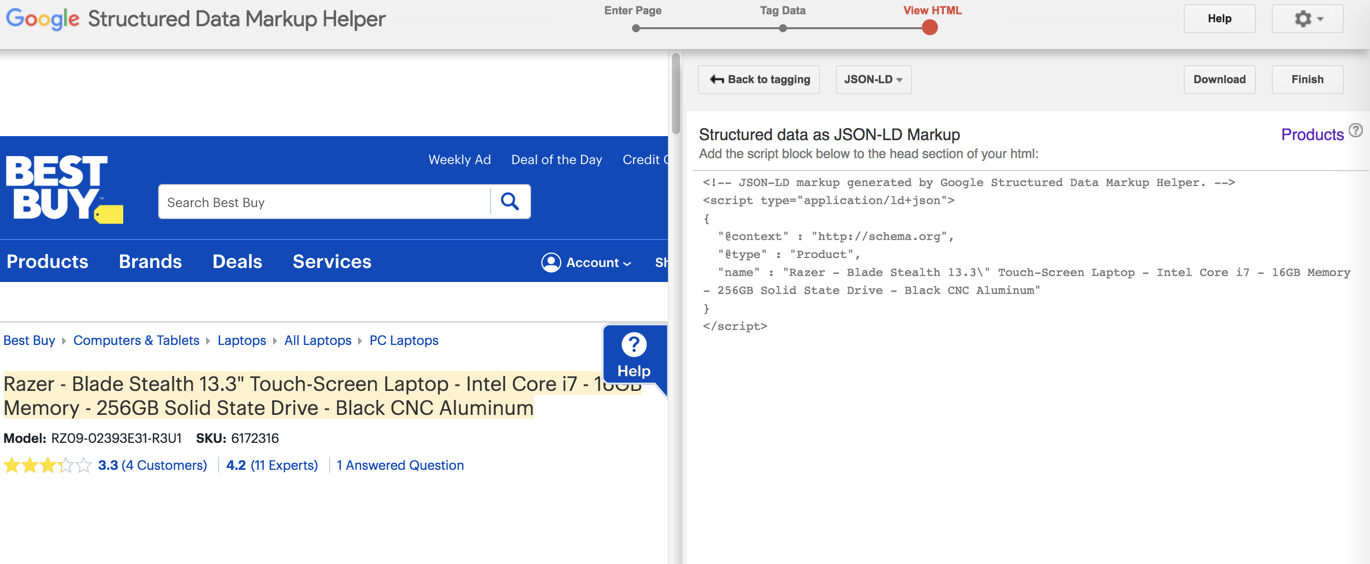
Google’s Structured Data Testing Tool
If you are trying to diagnose why your website is not showing rich results or trying to validate your new implementation of structured data, the Structured Data Testing Tool will come in handy. Simply input a URL or paste in the raw HTML of a particular page.
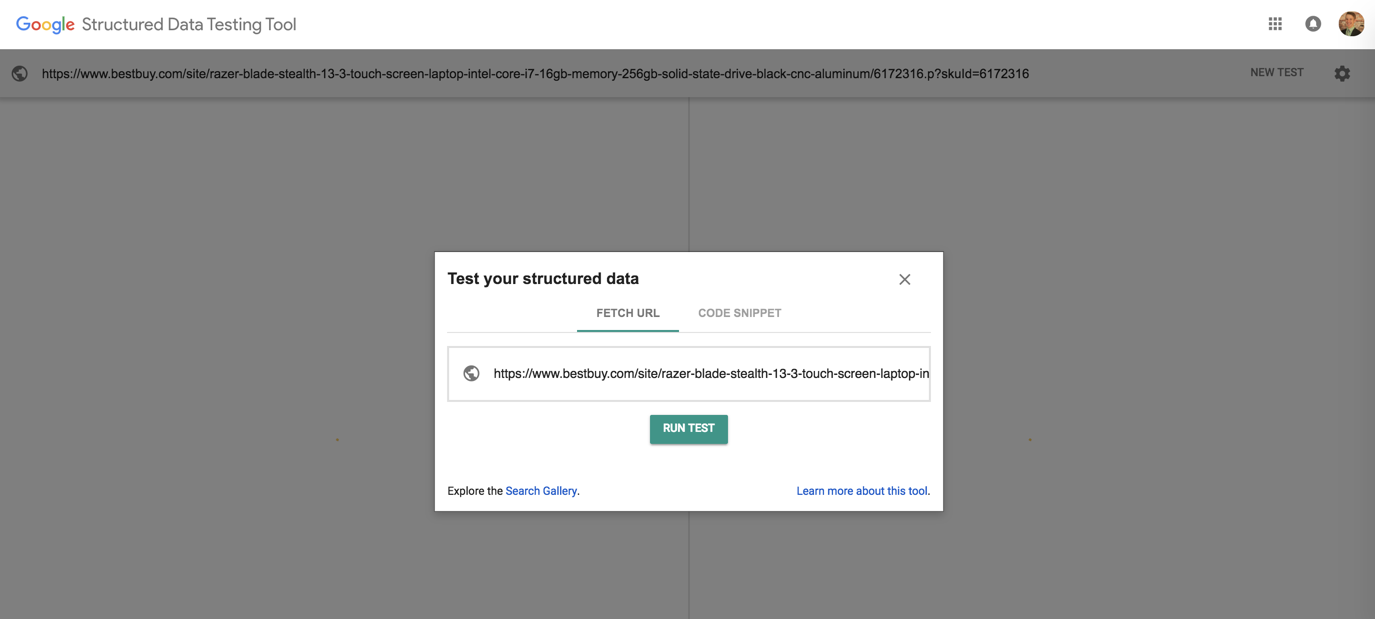
The tool will output what it believes you have provided it and/or any applicable errors with your implementation:
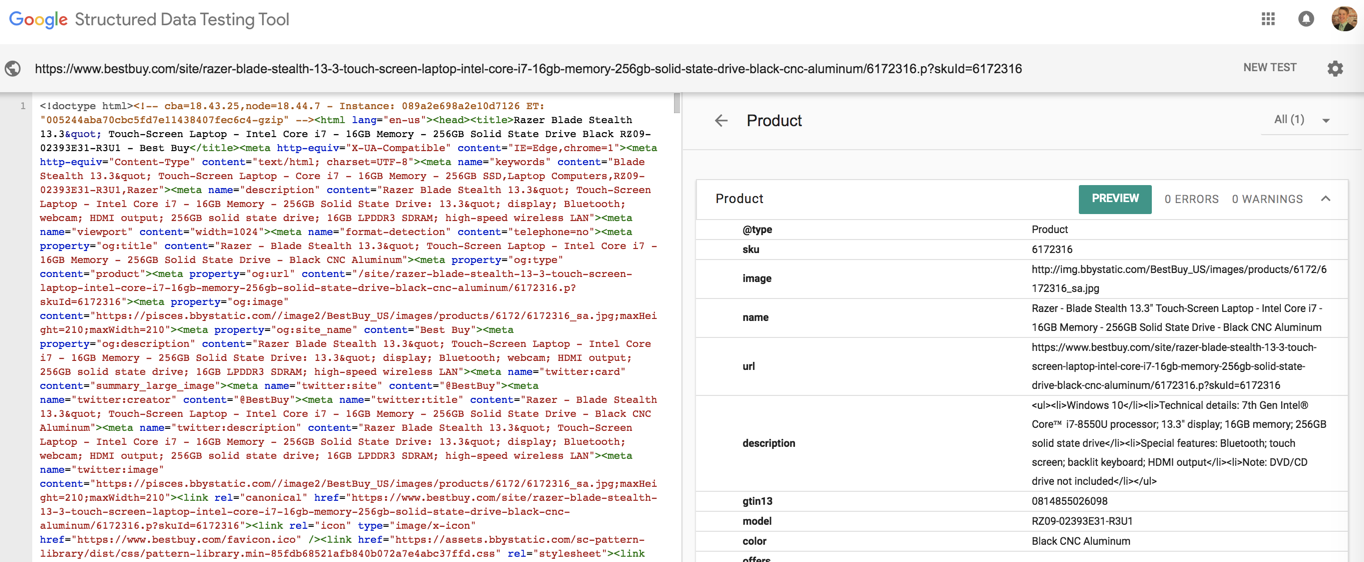
There are other tools that will let you validate URLs in bulk such as Screaming Frog and Sitebulb, but Google’s tool tends to get the job done for the average merchant.
Rich Results Are Not a Quick Win; They Are Essential to Your Online Success
Ensuring that your customers’ expectations are met when they click-thru to your website from organic search is paramount to your success as an online retailer, especially as the search engines and the SEO industry move from execution based on keywords to strategizing based on user intent.
Implementing structured data to make your search listings stand out among a sea of competitors will help your top-listings perform better, and showing customers price, availability, and aggregate ratings will build up your online reputation with potential customers.
Bonus Tip: If you made it all the way through this article and want to further enhance the product objects in your ecommerce store, consider adding additional attributes from the Product Ontology library. Many retailers are not yet using this additional type of data, and it can further specify exactly what you are selling to customers for search engines.
Companies That Are Killing It With Rich Results
Just a few examples for you to consider before you go.
REI Co-op

Dick’s Sporting Goods

Target

Let me know your tips for ecommerce rich results in the comments below.
